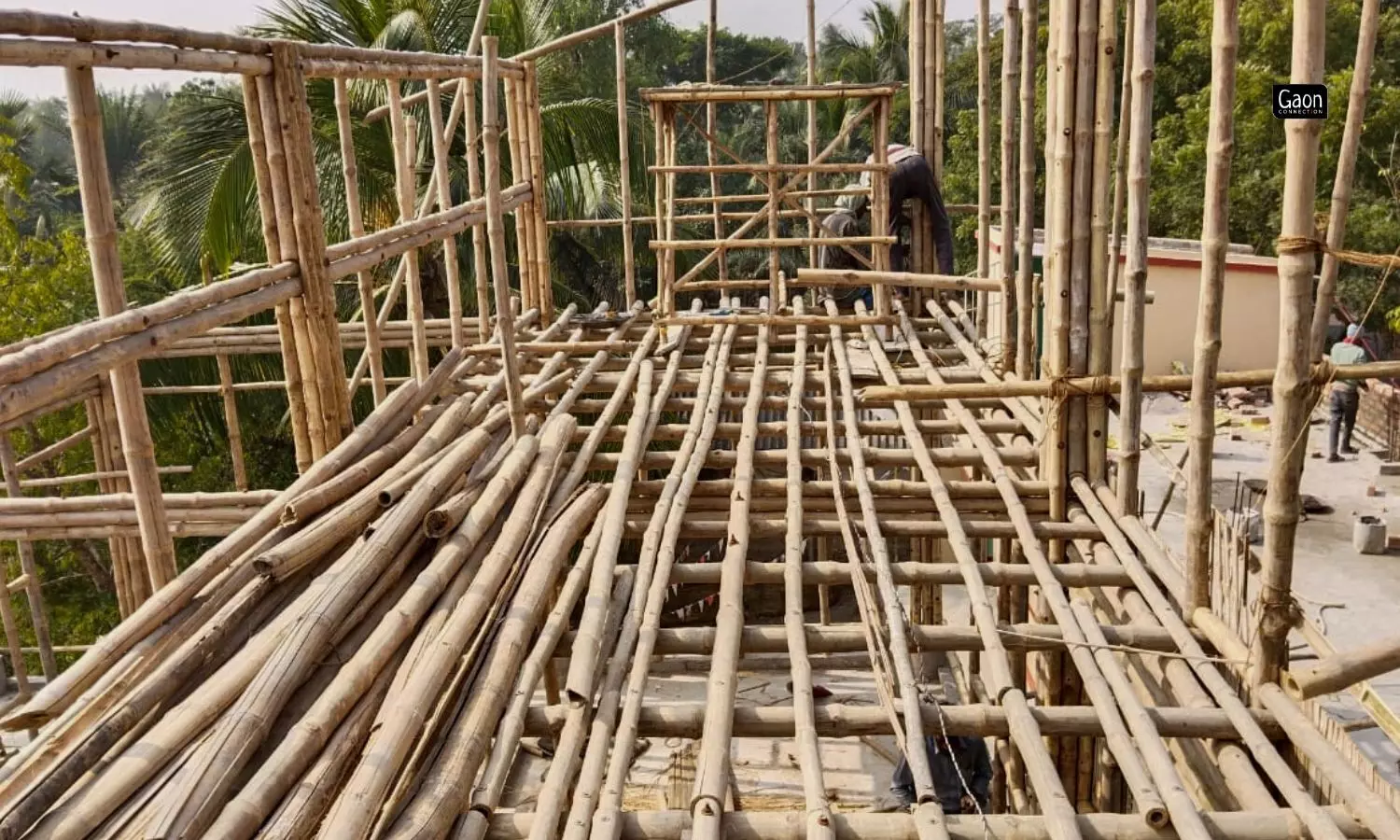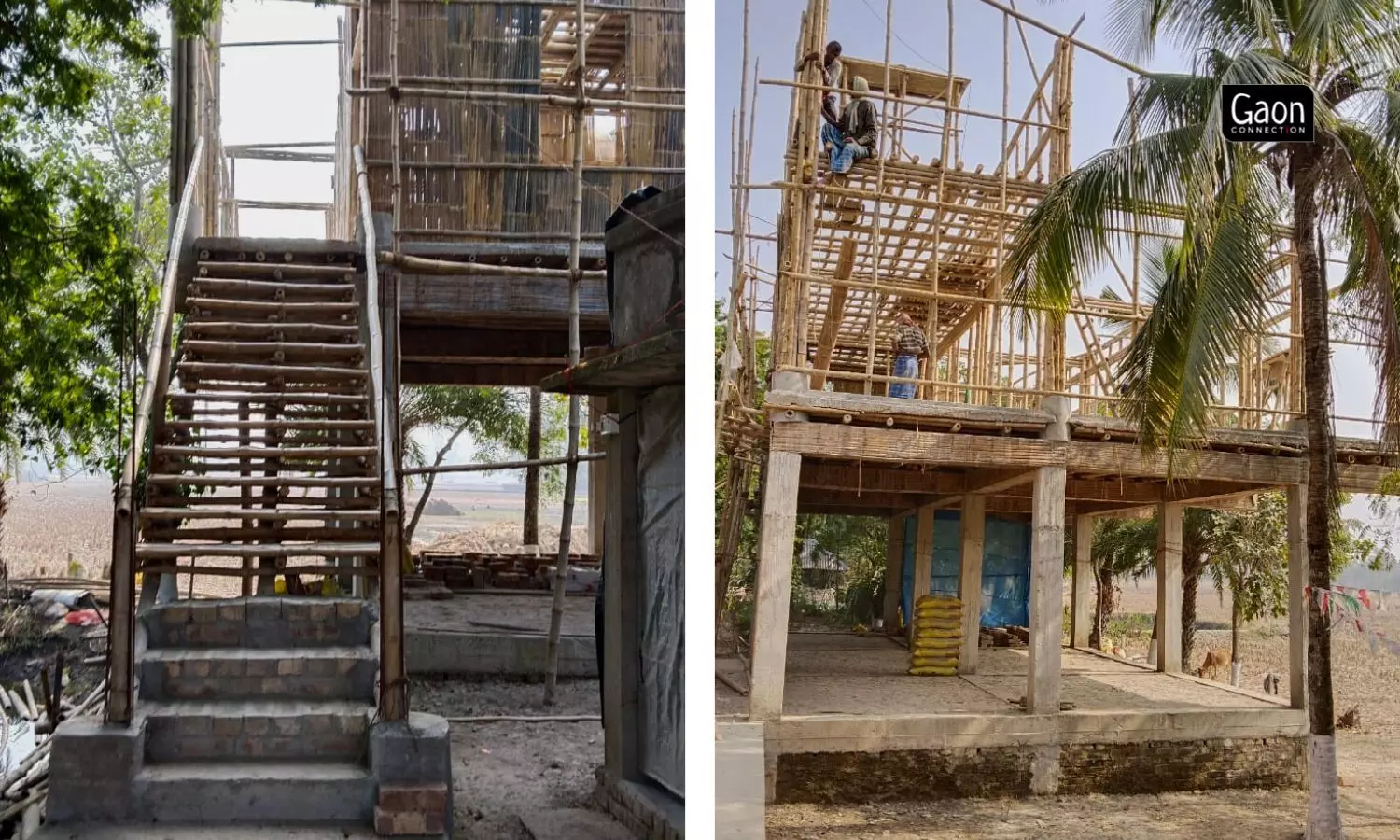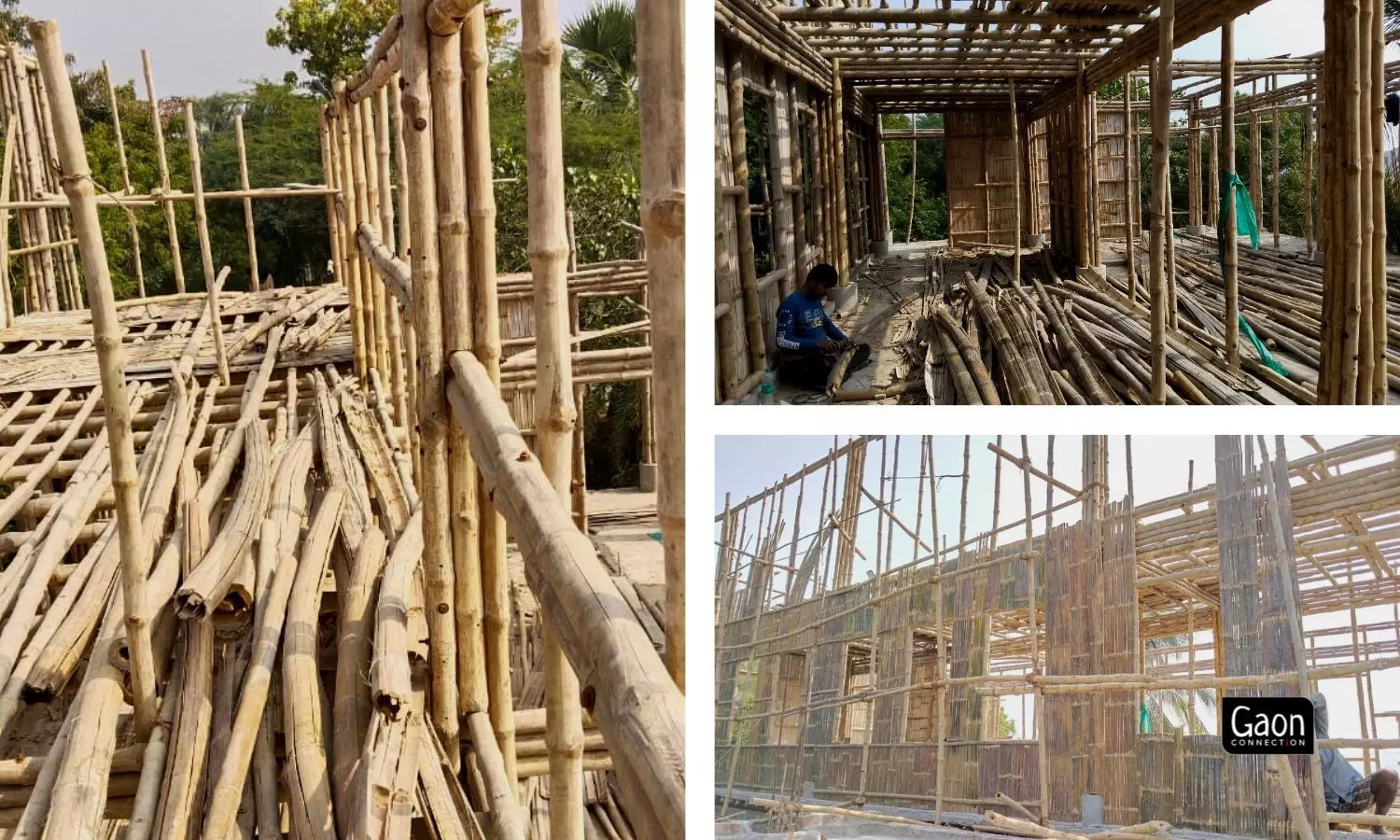Sundarbans, the world’s largest active delta, shared between India (West Bengal) and Bangladesh, is notorious for cyclones that hit its low-lying islands every now and then.
As sea levels rise due to global warming and tropical cyclones get more intense, the delta that is covered with large mangrove forests and is inhabited by one of the poorest of communities in the country, is at a high risk due to climate change. Villagers not only lose their crops and houses to storms, displacement and migration are on the rise.
Since early this year, an initiative is trying to respond to the challenges posed by cyclonic storms, by involving local communities in building climate resilient storm shelters.
These shelters are being constructed using locally available materials, such as bamboo and clay, and are also supplementing the income of local villagers who have been trained by Dighir Ganguly Foundation Trust (DGFT) to build these sturdy structures. The Foundation is a non-profit in Rajarhat Gopalpur in North 24 Parganas district in West Bengal.

An initiative is trying to respond to the challenges posed by cyclonic storms, by involving local communities in building climate resilient storm shelters.
In times of a disaster, these storm shelters offer safe haven to villagers and also offer basic health services.
One such storm shelter has been under construction in Jogeshganj village since February this year and is likely to be completed in the next three months. Close to 450 Munda families stay in the village and the area is accessible only by boat. During an emergency, access to these communities becomes difficult.
Also Read: In the Sundarbans, Fish is Gold
The construction of the storm shelter in his village, which is located in Hingalganj district of 24 Parganas North, has brought cheer to Vinod Kayal, a 46-year-old tribal inhabitant who is a carpenter by occupation.
“Not only has it provided me with employment opportunities as a construction worker but I feel safer living in my village now. Cyclones are frequent here and it is dangerous in our mud houses during the storms,” Kayal, who belongs to the Munda tribal community, told Gaon Connection.
The 46-year-old used to work as a carpenter in a small wood workshop until he got an offer from the Dighir Ganguly Foundation Trust in June this year to work as a construction worker and help build a storm shelter in his village.

In times of a disaster, these storm shelters offer safe haven to villagers and also offer basic health services.
“Since I started working with the NGO, I have been able to make Rs 500 to Rs 1,000 daily depending on the amount of work; earlier I hardly made Rs 500 a day, as and when I found work. It was difficult to make ends meet with such a small amount,” said Kayal. “Here we are taught techniques to make structures using bamboo and concrete so that they are disaster resilient,” he added.
“Prior to this I used to make bamboo furniture so I had a fair idea of making things with bamboo. But, I had not worked as a construction labourer before. With the training I can now build shelters,” Kayal said.
Aurgho Jyoti, Founder and Creative Director of AUR and lead design architect for the project, said, “This is a scalable prototype that could be replicated in other remote areas of Sundarbans. We realise that along with addressing issues of climate change and upliftment of the tribals the project creates meaning and permanence while providing vernacular and material continuity of their lived traditions.”
Climate Resilient Storm Shelters
The community storm shelter project being implemented in the Sundarbans is a collaboration between New Delhi and New York-based architecture firm AUR (Architecture Urbanism Research), the Dighir Ganguly Foundation Trust, and the Shelter Promotion Council of India. AUR has led the architecture and building technology of the project, SPCI has led community research efforts, and DGFI provided extensive ground support and logistical framework with their work in health and education.
Dighir Ganguly Foundation Trust is constructing the specially designed structures with the help of construction workers from the local Munda community.
It held workshops for the Munda people, who were hit the most due to Cyclone Amphan in 2020, and invited them to join the building project. The community members took keen interest as they lost all their land on which they did fishing and agriculture in the cyclone.

Dighir Ganguly Foundation Trust is constructing the specially designed structures with the help of construction workers from the local Munda community.
The health cum storm shelter, which is under construction in Jogeshganj village, has a stilt foundation which is supported by columns made of bamboo sticks. The wall panels are all modular and are installed on a bamboo structure.
It is about 2,400 square feet (two floors of 1,200 square feet each) with five rooms — one is an operation theatre, second is an OPD and the third is the waiting area. There are six beds in the hall with two storage rooms.
“At the beginning of this year, we formed a team of workers from the local Munda inhabitants and trained them. They were hard hit during Cyclone Amphan and we took it upon ourselves to help them,” said Soumen Ganguly, president and co-founder of Dighir Ganguly Foundation Trust.
“At the time of Amphan it was impossible to reach the communities living there as it was surrounded by water. So that gave us the idea to build a community health shelter made of bamboo and on stilts,” Sayantan Mitra, the 45-year-old president of Shelter Promotion Council told Gaon Connection.

The health cum storm shelter, which is under construction in Jogeshganj village, has a stilt foundation which is supported by columns made of bamboo sticks.
“Our idea is to help accommodate people and their important belongings because most of the times when a cyclone hits, people don’t have a safe place. The sustainable shelter we have designed will help them do that,” Mitra added.
There is a backstory to why Dighir Ganguly Foundation Trust is working on climate resilient structures with the local communities. “My son wanted to work with the weaker and marginalised communities but he died in 2014, at the age of 22, in an accident. In 2015, I decided to make a trust in his name and help the poor communities and that is when Dighir Ganguly Foundation Trust was started,” Soumen Ganguly narrated.
Climate Resilience Through Innovation
This project in the Sundarbans has received support from the New Delhi-based non-profit, Sustainable Environment and Ecological Development Society (SEEDS), which recently onboarded 11 grassroots organisations to pivot its ‘climate resilience through innovation’ campaign.
Called ‘Flip the Notion’, SEEDS showcased their work at an event in New Delhi. Vernacular Architecture and Resilient Structures, as the Sundarbans project is titled, is one of the 11 innovators chosen under the project.
“A quick look at the history of disasters on the coast of West Bengal brings to mind storms like Bulbul, Aila, Amphan and Yaas. These have been frequently impacting communities of the Sundarbans region in West Bengal where there is also an impending risk of coastal erosion,” Manu Gupta, Co founder SEEDS, told Gaon Connection.
“The intervention by the DGFT [Dighir Ganguly Foundation Trust] offers a pathway for protection of lives and livestock in coastal communities against flooding, strong winds, and large waves,” he said.

Bamboo is affordable, strong and climate resilient. We use cement along with it to build a reinforced concrete system to make stilt structures.
Talking about the storm shelters being constructed in Sundarbans, Gupta said: “Our experience has taught us that during a disaster, buildings can be drivers of risk — if not resilient. The structure in the Sundarbans uses bamboo which is well known and widely accepted as a disaster resilient material. Fortunately, bamboo is available in abundance here.”
“Use of bamboo in traditional styles of architecture using local indigenous styles of construction therefore, makes such structures resilient to the onslaught of climate vagaries,” Gupta pointed out.
Also Read: Crocodile at the workplace: The battle of the Sundarbans women to bring you your wild tiger prawns
Subhradip Roy, Director at AUR and Technical Lead for the project, seconded Gupta. “Bamboo is affordable, strong and climate resilient. We use cement along with it to build a reinforced concrete system to make stilt structures. The structure is divided into two parts, the first floor will be used for keeping the belongings and the second floor will accommodate the people, approximately 80-100 villagers,” said the 37-year-old architect.
“We use bamboo because it is disaster resilient and cost effective too. It is a four layer process in which the first layer is of concrete, second is the bamboo lattice structure, third is flattened bamboo and the last is mixing it with the cement and waiting for it to solidify properly. There are almost 800-1000 bamboos used in building this shelter and another 500 bamboo sticks are used for flattening purposes,” he explained.
Dighir Pathshaala
Apart from the storm shelter, a school called ‘Dighir Pathshaala’ has also been started by the trust named after the founder’s deceased son, Dighir. It was inaugurated on December 17 this year.
The construction for the school began in February 2023, it is a coaching centre cum non-formal school. There are 96 children from nursery to class fourth with an open library. There are three rooms in this school.
Students study in two shifts, morning and evening. The children also go to a formal school. There are four teachers recruited for teaching them.




















